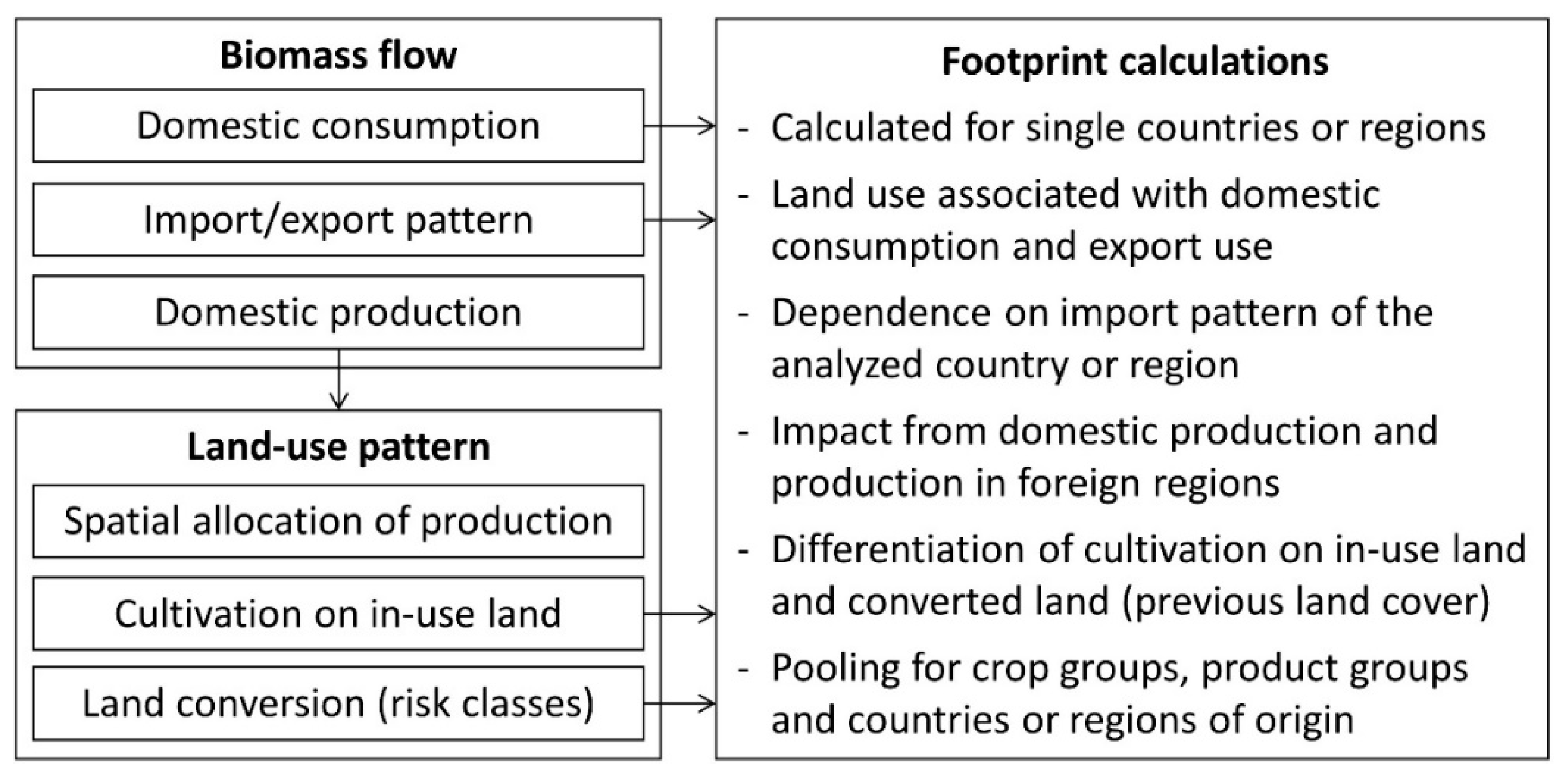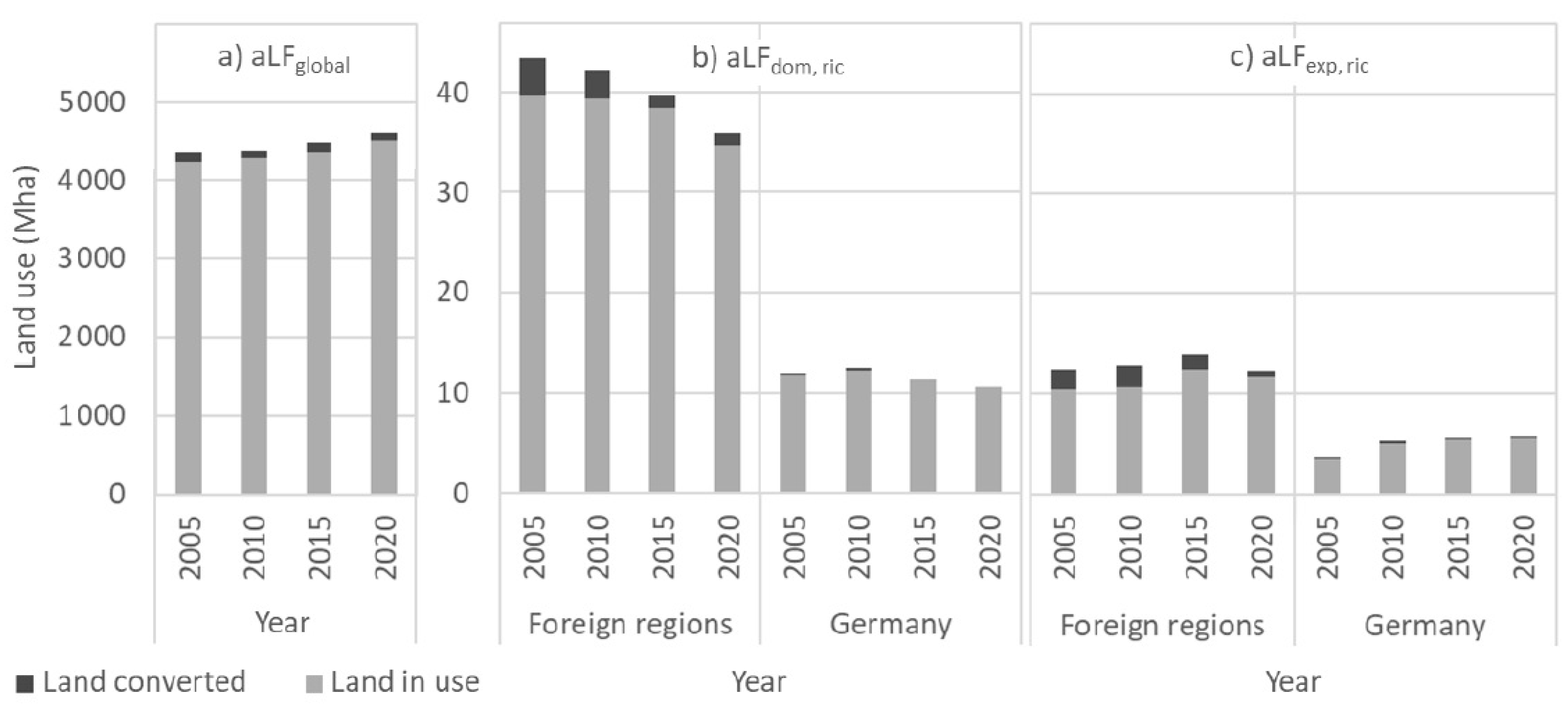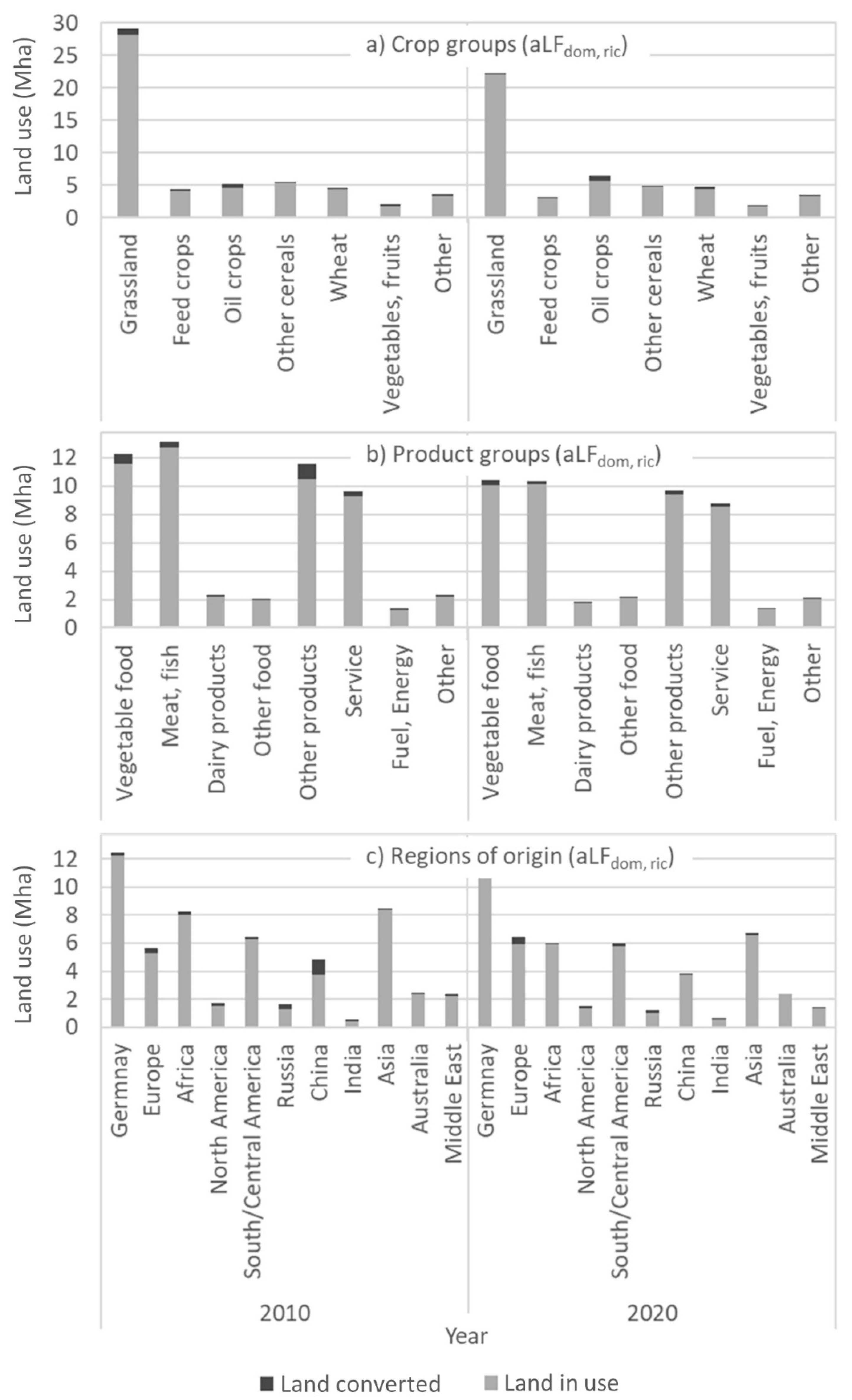Germany’s Agricultural Land Footprint and the Impact of Import Pattern Allocation
Abstract
:1. Introduction
- (i)
- How much agricultural land is used globally for the German bioeconomy and for which crops in which region of the world?
- (ii)
- To what extent are natural and semi-natural land areas converted to agricultural land due to the German bioeconomy?
- (iii)
- How much do changes of import patterns affect the results when including them in the calculation of aLF?
2. Materials and Methods
2.1. Overview of the Footprint Method
- Biomass flows between countries/regions are derived from the multi-regional input-output (MRIO) model that is based on EXIOBASE.
- Domestic crop production of each country/region serves as input to the global land use model LandSHIFT [30]. LandSHIFT calculates the spatial pattern of agricultural land use (cropland, grassland) and additional conversion of natural and semi-natural land to agriculture.
- The footprint calculation is carried out for a single country or region based on the results of the MRIO model and LandSHIFT.
2.2. Biomass Flows
2.3. Global Land-Use Patterns
2.4. Footprint Calculations
2.5. Case Study Germany
- Analysis related to import changes (ric) and domestic use (aLFdom, ric);
- Analysis related to import changes (ric) and export use including re-export (aLFexp, ric);
- Analysis not related to import changes (not-ric) and domestic use (aLFdom, no-ric);
- Analysis not related to import changes (not-ric) and export use including re-export (aLFexp, not-ric).
3. Results
3.1. Land Used by the German Bioeconomy
3.2. Land Converted by the German Bioeconomy
3.3. Allocation of Changes of Import Patterns
4. Discussion
4.1. Land Used by the German Bioeconomy
4.2. Land Converted by the German Bioeconomy
4.3. Allocation of Changes of Import Patterns
5. Conclusions
Author Contributions
Funding
Institutional Review Board Statement
Informed Consent Statement
Data Availability Statement
Acknowledgments
Conflicts of Interest
References
- IPBES. Global Assessment Report on Biodiversity and Ecosystem Services of the Intergovernmental Science-Policy Platform on Biodiversity and Ecosystem Services; Brondizio, E.S., Settele, J., Díaz, S., Ngo, H.T., Eds.; IPBES Secretariat: Bonn, Germany, 2019. [Google Scholar]
- WBGU. Landwende im Anthropozän: Von der Konkurrenz zur Integration. Berlin. 2020. Available online: https://www.wbgu.de/fileadmin/user_upload/wbgu/publikationen/hauptgutachten/hg2020/pdf/WBGU_HG2020_ZF.pdf (accessed on 22 November 2021).
- Moore, J.C. The re-imagining of a framework for agricultural land use: A pathway for integrating agricultural practices into ecosystem services, planetary boundaries and sustainable development goals. Ambio 2021, 50, 1295–1298. [Google Scholar] [CrossRef]
- European Commission. A Sustainable Bioeconomy for Europe: Strengthening the Connection between Economy, Society and the Environment: Updated Bioeconomy Strategy; European Commission: Brussels, Belgium, 2018. [Google Scholar]
- Meyer, R. Bioeconomy Strategies: Contexts, Visions, Guiding Implementation Principles and Resulting Debates. Sustainability 2017, 9, 1031. [Google Scholar] [CrossRef] [Green Version]
- Kuosmanen, T.; Kuosmanen, N.; El-Meligli, A.; Ronzon, T.; Gurria, P.; Iost, S.; M’Barek, R. How Big Is the Bioeconomy? Reflections from an Economic Perspective; Publications Office of the European Union: Luxembourg, 2020. [Google Scholar]
- Heimann, T. Bioeconomy and SDGs: Does the bioeconomy support the achievement of the SDGs? Earth’s Future 2019, 7, 43–57. [Google Scholar] [CrossRef] [Green Version]
- Linser, S.; Lier, M. The contribution of sustainable development goals and forest-related indicators to national bioeconomy progress monitoring. Sustainability 2020, 12, 2898. [Google Scholar] [CrossRef] [Green Version]
- O’Brien, M.; Wechsler, D.; Bringezu, S.; Schaldach, R. Toward a systemic monitoring of the European bioeconomy: Gaps, needs and the integration of sustainability indicators and targets for global land use. Land Use Policy 2017, 66, 162–171. [Google Scholar] [CrossRef]
- Bracco, S.; Calicioglu, O.; Gomez San Juan, M.; Flammini, A. Assessing the Contribution of Bioeconomy to the Total Economy: A Review of National Frameworks. Sustainability 2018, 10, 1698. [Google Scholar] [CrossRef] [Green Version]
- Giuntoli, J.; Robert, N.; Ronzon, T.; Sanchez Lopez, J.; Follador, M.; Girardi, I.; Barredo Cano, J.; Borzacchiello, M.; Sala, S.; M’Barek, R.; et al. Building a Monitoring System for the EU Bioeconomy; Publications Office of the European Union: Luxembourg, 2020; ISBN 978-92-76-15385-6. [Google Scholar]
- Kilsedar, C.E.; Wertz, S.; Robert, N.; Mubareka, S. Implementation of the EU Bioeconomy Monitoring System Dashboards: Status and Technical Description as of December 2020; Publications Office of the European Union: Luxembourg, 2021; ISBN 978-92-76-28946-3. [Google Scholar]
- Bracco, S.; Tani, A.; Çalıcıoğlu, Ö.; Gomez San Juan, M.; Bogdanski, A. Indicators to Monitor and Evaluate the Sustainability of Bioeconomy. Overview and a Proposed Way Forward. Rome. 2019. Available online: https://www.fao.org/3/ca6048en/CA6048EN.pdf (accessed on 22 November 2021).
- ISO 14046:2014. Environmental Management—Water Footprint—Principles, Requirements and Guidelines; International Organization for Standardization: Geneva, Switzerland, 2014. [Google Scholar]
- ISO 14067:2018. Greenhouse Gases—Carbon Footprint of Products—Requirements and Guidelines for Quantification; International Organization for Standardization: Geneva, Switzerland, 2018. [Google Scholar]
- Giljum, S.; Wieland, H.; Lutter, S.; Bruckner, M.; Wood, R.; Tukker, A.; Stadler, K. Identifying priority areas for European resource policies: A MRIO-based material footprint assessment. J. Econ. Struct. 2016, 5, 17. [Google Scholar] [CrossRef] [Green Version]
- Bruckner, M.; Häyhä, T.; Giljum, S.; Maus, V.; Fischer, G.; Tramberend, S.; Börner, J. Quantifying the global cropland footprint of the European Union’s non-food bioeconomy. Environ. Res. Lett. 2019, 14, 45011. [Google Scholar] [CrossRef]
- Liobikiene, G.; Chen, X.; Streimikiene, D.; Balezentis, T. The trends in bioeconomy development in the European Union: Exploiting capacity and productivity measures based on the land footprint approach. Land Use Policy 2020, 91, 104375. [Google Scholar] [CrossRef]
- Bruckner, M.; Giljum, S.; Fischer, G.; Tramberend, S. Review of Land Flow Accounting Methods and Recommendations for Further Development; German Environment Agency: Dessau-Roßlau, Germany, 2017. [Google Scholar]
- Bringezu, S.; Banse, M.; Ahmann, L.; Bezama, N.A.; Billig, E.; Bischof, R.; Blanke, C.; Brosowski, A.; Brüning, S.; Borchers, M.; et al. Pilotbericht zum Monitoring der Deutschen Bioökonomie; Center for Environmental Systems Research (CESR), Universität Kassel: Kassel, Germany, 2020. [Google Scholar]
- Bringezu, S.; Distelkamp, M.; Lutz, C.; Wimmer, F.; Schaldach, R.; Hennenberg, K.J.; Böttcher, H.; Egenolf, V. Environmental and socioeconomic footprints of the German bioeconomy. Nat. Sustain. 2021, 4, 775–783. [Google Scholar] [CrossRef]
- Fischer, G.; Tramberend, S.; Bruckner, M.; Lieber, M. Quantifying the Land Footprint of Germany and the EU Using a Hybrid Accounting Model; Umweltbundesamt: Dessau-Roßlau, Germany, 2017. Available online: https://www.umweltbundesamt.de/sites/default/files/medien/1410/publikationen/2017-09-06_texte_78-2017_quantifying-land-footprint.pdf (accessed on 22 November 2021).
- Hennenberg, K.J.; Dragisic, C.; Haye, S.; Hewson, J.; Semroc, B.; Savy, C.; Wiegmann, W.; Fehrenbach, H.; Fritsche, U.R. The power of bioenergy-related standards to protect biodiversity. Conserv. Biol. 2010, 24, 412–423. [Google Scholar] [CrossRef] [PubMed]
- Pereira, H.M.; Navarro, L.M.; Martins, I.S. Global biodiversity change: The bad, the good, and the unknown. Annu. Rev. Environ. Resour. 2012, 37, 25–50. [Google Scholar] [CrossRef] [Green Version]
- Kehoe, L.; Romero-Muñoz, A.; Polaina, E.; Estes, L.; Kreft, H.; Kuemmerle, T. Biodiversity at risk under future cropland expansion and intensification. Nat. Ecol. Evol. 2017, 1, 1129–1135. [Google Scholar] [CrossRef] [PubMed]
- Hasan, S.S.; Zhen, L.; Miah, M.G.; Ahamed, T.; Samie, A. Impact of land use change on ecosystem services: A review. Environ. Dev. 2020, 34, 100527. [Google Scholar] [CrossRef]
- Borrellia, P.; Robinsonc, D.A.; Panagosd, P.; Lugatod, E.; Yangb, J.E.; Alewella, C.; Wueppere, D.; Montanarellad, L.; Ballabiod, C. Land use and climate change impacts on global soil erosion by water (2015–2070). Proc. Natl. Acad. Sci. USA 2020, 117, 21994–22001. [Google Scholar] [CrossRef] [PubMed]
- Wierik, S.A.T.; Cammeraat, E.L.H.; Gupta, J.; Artzy-Randrup, Y.A. Reviewing the impact of land use and land-use change on moisture recycling and precipitation patterns. Water Resour. Res. 2021, 57, e2020WR029234. [Google Scholar] [CrossRef]
- Lamb, W.F.; Wiedmann, T.; Pongratz, J.; Andrew, R.; Crippa, M.; Olivier, J.G.J.; Wiedenhofer, D.; Mattioli, G.; Al Khourdajie, A.; House, J.; et al. A review of trends and drivers of greenhouse gas emissions by sector from 1990 to 2018. Environ. Res. Lett. 2021, 16, 73005. [Google Scholar] [CrossRef]
- Schaldach, R.; Koch, J.; der Beek, T.A.; Kynast, E.; Flörke, M. Current and future irrigation water requirements in pan-Europe: An integratedanalysis of socio-economic and climate scenarios. Glob. Planet. Chang. 2012, 94–95, 33–45. [Google Scholar] [CrossRef]
- Bundesministerium für Ernährungund Landwirtschaft. Fortschrittsbericht zur Nationalen Politikstrategie Bioökonomie. 2016. Available online: https://www.bmel.de/SharedDocs/Downloads/DE/Broschueren/Fortschrittsbericht-Biooekonomie.pdf;jsessionid=AA46C39D03E7ECE32D237152034228EC.live842?__blob=publicationFile&v=2 (accessed on 22 November 2021).
- Riahi, K.; Van Vuuren, D.P.; Kriegler, E.; Edmonds, J.; O’neill, B.C.; Fujimori, S.; Bauer, N.; Calvin, K.; Dellink, R.; Fricko, O.; et al. The Shared Socioeconomic Pathways and their energy, land use, and greenhouse gas emissions implications: An overview. Glob. Environ. Chang. 2017, 42, 153–168. [Google Scholar] [CrossRef] [Green Version]
- O’Neill, B.C.; Kriegler, E.; Ebi, K.L.; Kemp-Benedict, E.; Riahi, K.; Rothman, D.S.; van Ruijven, B.J.; van Vuuren, D.P.; Birkmann, J.; Kok, K.; et al. The roads ahead: Narratives for shared socioeconomic pathways describing world futures in the 21st century. Glob. Environ. Chang. 2017, 42, 169–180. [Google Scholar] [CrossRef] [Green Version]
- United Nations. World Population Prospects 2019: Volume I: Comprehensive Tables. 2019. Available online: https://population.un.org/wpp/Publications/Files/WPP2019_Volume-I_Comprehensive-Tables.pdf (accessed on 22 November 2021).
- Dellink, R.; Chateau, J.; Lanzi, E.; Magné, B. Long-term economic growth projections in the Shared Socioeconomic Pathways. Glob. Environ. Chang. 2017, 42, 200–214. [Google Scholar] [CrossRef]
- Lutz, C.; Becker, L.; Ulrich, P.; Distelkamp, M. Sozioökonomische Szenarien als Grundlage der Vulnerabilitätsanalysen für Deutschland: Teilbericht des Vorhabens “Politikinstrumente zur Klimaanpassung”, Dessau-Roßlau. 2019. Available online: https://www.umweltbundesamt.de/sites/default/files/medien/1410/publikationen/2019-05-29_cc_25-2019_soziooekonomszenarien.pdf (accessed on 22 November 2021).
- Schaldach, R.; Alcamo, J.; Koch, J.; Kölking, C.; Lapola, D.M.; Schüngel, J.; Priess, J.A. An integrated approach to modelling land-use change on continental and global scales. Environ. Modell. Softw. 2011, 26, 1041–1051. [Google Scholar] [CrossRef]
- Bondeau, A.; Smith, P.; Zaehle, S.; Schaphoff, S.; Lucht, W.; Cramer, W.; Gerten, D.; Lotze-Campen, H.; Müller, C.; Reichstein, M.; et al. Modelling the role of agriculture for the 20th century global terrestrial carbon balance. Glob. Chang. Biol. 2007, 13, 679–706. [Google Scholar] [CrossRef]
- CCI. ESA Climate Change Initiative—Land Cover Led by UCLouvain. 2017. Available online: http://maps.elie.ucl.ac.be/CCI/viewer/download.php (accessed on 22 November 2021).
- ESA. Land Cover CCI Product User Guide Version 2. 2017. Available online: Maps.elie.ucl.ac.be/CCI/viewer/download/ESACCI-LC-Ph2-PUGv2_2.0.pdf (accessed on 22 November 2021).
- FAO. FAOSTAT Database Collections. Rome. 2020. Available online: http://faostat.fao.org (accessed on 31 January 2020).
- Egenolf, V.; Bringezu, S. Conceptualization of an indicator system for assessing the sustainability of the bioeconomy. Sustainability 2019, 11, 443. [Google Scholar] [CrossRef] [Green Version]
- Winkler, K.; Fuchs, R.; Rounsevell, M.; Herold, M. Global land use changes are four times greater than previously estimated. Nat. Commun. 2021, 12, 2501. [Google Scholar] [CrossRef]
- Henders, S.; Persson, U.M.; Kastner, T. Trading forests: Land-use change and carbon emissions embodied in production and exports of forest-risk commodities. Environ. Res. Lett. 2015, 10, 125012. [Google Scholar] [CrossRef]
- European Commission. The Impact of EU Consumption on Deforestation: Comprehensive Analysis of the Impact of EU Consumption on Deforestation; European Commission: Brussels, Belgium, 2013; ISBN 9789279289262. [Google Scholar]
- Lüker-Jansa, N.; Simmering, D.; Otte, A. The impact of biogas plants on regional dynamics of permanent grassland and maize area—The example of Hesse, Germany (2005–2010). Agr. Ecosyst. Environ. 2017, 241, 24–38. [Google Scholar] [CrossRef]
- Umweltbundesamt. Projektionsbericht 2021 für Deutschland: Gemäß Artikel 18 der Verordnung (EU) 2018/1999 des Europäischen Parlaments und des Rates vom 11. Dezember 2018 über das Governance-System für die Energieunion und für den Klimaschutz, zur Änderung der Verordnungen (EG) Nr. 663/2009 und (EG) Nr. 715/2009 des Europäischen Parlaments und des Rates sowie §10 (2) des Bundes-Klimaschutzgesetzes. 2021. Available online: https://www.bmu.de/fileadmin/Daten_BMU/Download_PDF/Klimaschutz/projektionsbericht_2021_bf.pdf (accessed on 22 November 2021).
- Dorninger, C.; von Wehrden, H.; Krausmann, F.; Bruckner, M.; Feng, K.; Hubacek, K.; Erb, K.; Abson, D.J. The effect of industrialization and globalization on domestic land-use: A global resource footprint perspective. Glob. Environ. Chang. 2021, 69, 102311. [Google Scholar] [CrossRef]
- Brooks, T.M.; Mittermeier, R.A.; Da Fonseca, G.A.B.; Gerlach, J.; Hoffmann, M.; Lamoreux, J.F.; Mittermeier, C.G.; Pilgrim, J.D.; Rodrigues, A.S.L. Global biodiversity conservation priorities. Science 2006, 313, 58–61. [Google Scholar] [CrossRef] [Green Version]





Publisher’s Note: MDPI stays neutral with regard to jurisdictional claims in published maps and institutional affiliations. |
© 2021 by the authors. Licensee MDPI, Basel, Switzerland. This article is an open access article distributed under the terms and conditions of the Creative Commons Attribution (CC BY) license (https://creativecommons.org/licenses/by/4.0/).
Share and Cite
Hennenberg, K.J.; Gebhardt, S.; Wimmer, F.; Distelkamp, M.; Lutz, C.; Böttcher, H.; Schaldach, R. Germany’s Agricultural Land Footprint and the Impact of Import Pattern Allocation. Sustainability 2022, 14, 105. https://doi.org/10.3390/su14010105
Hennenberg KJ, Gebhardt S, Wimmer F, Distelkamp M, Lutz C, Böttcher H, Schaldach R. Germany’s Agricultural Land Footprint and the Impact of Import Pattern Allocation. Sustainability. 2022; 14(1):105. https://doi.org/10.3390/su14010105
Chicago/Turabian StyleHennenberg, Klaus Josef, Swantje Gebhardt, Florian Wimmer, Martin Distelkamp, Christian Lutz, Hannes Böttcher, and Rüdiger Schaldach. 2022. "Germany’s Agricultural Land Footprint and the Impact of Import Pattern Allocation" Sustainability 14, no. 1: 105. https://doi.org/10.3390/su14010105
APA StyleHennenberg, K. J., Gebhardt, S., Wimmer, F., Distelkamp, M., Lutz, C., Böttcher, H., & Schaldach, R. (2022). Germany’s Agricultural Land Footprint and the Impact of Import Pattern Allocation. Sustainability, 14(1), 105. https://doi.org/10.3390/su14010105






